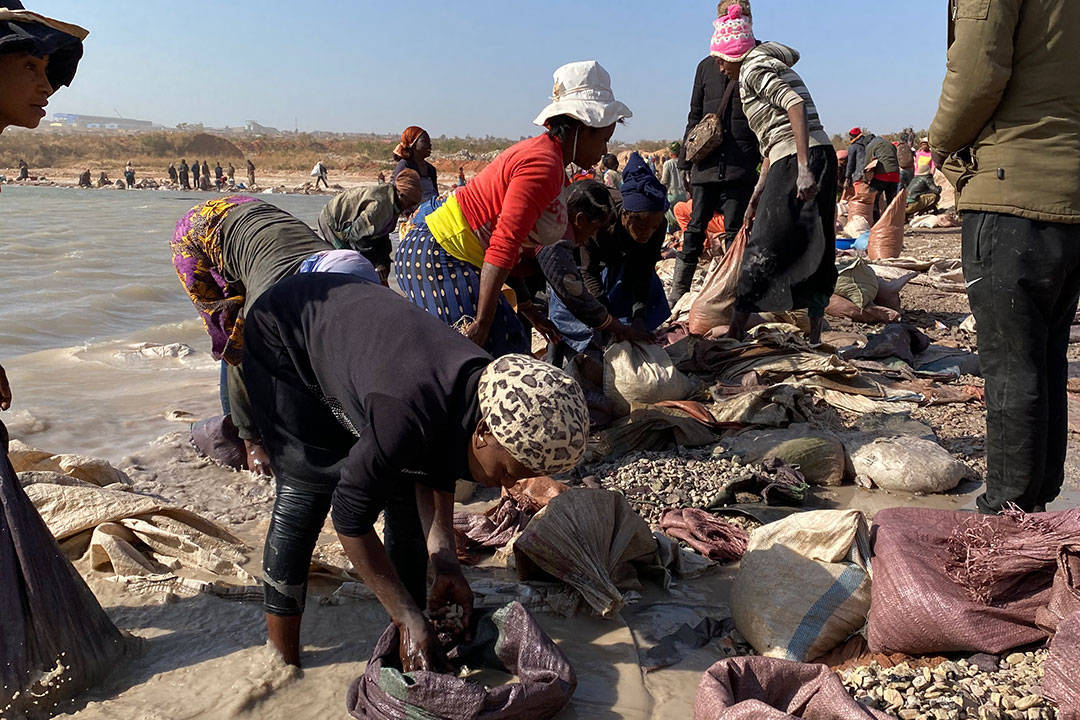Challenges to Securing a More Socially Sustainable Cobalt Supply for the UK
The transition to a low-carbon economy demands intense extraction of critical minerals such as cobalt, raising urgent questions about social and environmental impacts across global supply chains.
Transitioning from a carbon-intensive to a net-zero global economy is one of the most urgent tasks facing humanity today. However, debates over how to meet low-carbon targets largely neglect the accompanying high intensity of mineral and metal extraction and processing this will require. A considerable number of critical energy transition minerals (ETMs) are required to develop the renewable energy technologies (such as photovoltaic cells, wind turbines, and rechargeable batteries) needed to drive a low-carbon economy, with resource-rich countries in the Global South playing a central role in supplying many of the required raw materials. Improvements in material efficiency, metal recycling and calls for new circular economic models will not be sufficient to meet net-zero targets on their own.
Cobalt, an essential ETM in rechargeable lithium-ion batteries for electric vehicles, is now widely heralded as a linchpin in the transition to a low-carbon economy. As demand for cobalt is expected to more than double over the next five years, there has been much discussion and debate about the sustainability of the supply chain, particularly in the Democratic Republic of the Congo (DRC), which sits on more than two-thirds of known global cobalt deposits. The social, (geo)political and environmental ‘fallout’ from increased cobalt demand will be enormous, both in the short-term and longer-term future (for example, increased water pollution/depletion, deforestation, biodiversity loss, social conflict, population displacement, and patterns of uneven development). In addition to the large-scale, capital-intensive extractive operations dominated by international mining companies, cobalt supply also relies significantly on informal artisanal and small-scale mining (ASM). Such operations are characterised by low-tech, labour-intensive activities that employ rudimentary hand tools and are typically undertaken by vulnerable communities who must endure dangerous conditions, human rights abuses and low pay. In the DRC, for example, estimates suggest that as much as 30% of the cobalt supply is being mined by a workforce of artisanal operators, referred to locally as 'creuseurs'.
Regulatory weakness, widespread corruption and structural inequalities embedded in supply chains mean that the risk – not economic value – flows to the most vulnerable workers, worsening their prospects in the process
An important question thus comes to the fore: are ETM supply increases feasible – and at what cost to people and to the environment? Further related questions emerge as to whether a renewed push for green energy will foster wider prosperity and new sustainable relationships between cobalt extraction, the environment and development, or whether a transition to a global low-carbon economy dependent upon cobalt demand will reproduce (and potentially deepen) inequalities, social conflict, and insecurity within and between countries.
Against this backdrop, we highlight here a number of ongoing challenges to addressing the impacts associated with rising ETM demand. More specifically, we explore how the UK government might leverage its position as a consumer, a global financial hub and host of the London Metal Exchange to improve the environmental, social and governance (ESG) performance of clean energy supply chains. Drawing on the case of cobalt, focusing on the responsibilities of firms, and linking to recent academic research on the weak performance of business and human rights (BHR) in supply chains, we reflect on both the conundrums faced and the policy options available to reduce the negative impacts of rising demand for cobalt.
ESG Performance
ESG has come to prominence as a framework through which to evaluate business investments and strategies that captures the ethical impact of business activities. That it is a ‘framework’ implies some important relationality between terms; environmental, social and governance are intertwined concepts, with some complex interdependencies.

Cobalt extraction provides a clear example of where this framework presents dilemmas; the evident negative impacts, and the loss of human lives and human dignity in many of the formal and informal global operations, eventually feed into ‘clean’ supply chains, meaning that there is some counter-coupling of the E and the S in ESG. In other words, rather than the E, S and G moving positively together, with firms delivering environmental performance for investors, they can induce – or even encourage – decreases in social performance. The intensity of the demand for the ETMs necessary to deliver on environmental goals heightens the levels of risk in expanding extractive operations, often generating negative social impacts.
In a perfect world, the ideal function of a market would be to drive improved standards, where economic value creation flows through the supply chain in equitable ways, ensuring that all workers and communities impacted by operations benefit from economic demand. However, regulatory weakness, widespread corruption and structural inequalities embedded in supply chains mean that the risk – not economic value – flows to the most vulnerable workers, worsening their prospects in the process. This is perhaps where the G comes in. The governance frameworks in firms seeking ESG investments should involve care for stakeholder implications, and yet shareholders continue to dominate firm decision-making, acting as a barrier to more impactful ESG investments. Recent research suggests that many investors do welcome attention paid to ESG initiatives, such as the International Labour Organization’s Declaration on Fundamental Human Rights, but they also tend to penalise those firms that do ‘too much’, or more than a perceived minimum. Unfortunately, it appears that ESG efforts on their own are not well geared to drive the significant change needed to protect human rights and ensure social sustainability in supply chains.
Negative impacts – human rights abuses in this instance – occur where there is: 1) supply chain complexity (buyers are protected from scrutiny); 2) contextual opacity (when observers struggle to establish causal links between a firm’s policies and particular outcomes); and 3) a host country with weak standards. All three of these drivers potentially feature in the case of cobalt production, meaning that that the cobalt supply chain is a red flag for negative social impacts, regardless of where it is perceived to be coming from. Due to the complexity of the supply chain, cobalt originating from different sources and refineries is eventually amalgamated along the supply chain. Causal links are hard to establish, and there is limited scope for consumer countries to ensure workers’ standards.
Overview of Policy Options
Against this backdrop, some possible policy counters include the following:
1) Regulatory incentives involving much longer-term views on economic performance are necessary to reduce the motivation for firms to prioritise short-term profits. These may include mechanisms that support an explicit balancing of economic returns with respect to social responsibilities.
Community and local government relations take time to develop, and firms do not always succeed in successfully integrating local stakeholders into their environment to properly take care of the communities they are impacting
2) Balanced reporting is also urgently needed. Non-financial reporting tends to highlight the positive impacts, while omitting the negative impacts that firms’ activities are having on local communities. Policies that require more accurate and faithful reporting of negative impacts, and explicit acknowledgement of the harms caused, are necessary to ensure that firms face up to their responsibilities.
3) Collective approaches to negative impacts are required at an industry level. Any firm, regardless of its own behaviour, should be involved in ensuring safe and sustainable working conditions in the location in which it is operating. Firms often possess the local access and understanding to enhance standards outside the confines of their own operations, and could extend this to other operations in the surrounding communities, including informal ASM operations which operate on their periphery.
Global Governance is Weak on Social Impacts
The UN’s Guiding Principles (UNGPs) are the de facto standards for BHR. They are a form of ‘soft’ law and not legally binding, but they expect a ‘knowing and showing’ where there should be an ongoing human rights due diligence (HRDD) process carried out by a firm. In theory, this involves a state of continual attention to, and learning about, the scope for potential human rights abuses in a firm’s supply chain to prevent infringements. In practice, however, data sources such as the Business and Human Rights Resource Centre find that human rights incidents are prevalent in supply chains in general, and in ETM extraction in particular.

As such, ‘harder and more stringent’ law is arriving with respect to HRDD, at least for firms in the EU that are subject to new corporate sustainability diligence legislation. However, it should be noted that European firms are not well prepared for this development. Although many of the largest firms are reliant on cobalt, recent research suggests that most approach HRDD with ‘lip service’, if at all. In a study of the top 100 European multinational corporations, it was revealed that in firm reporting, rhetorical commitments and future promises outweighed substantive actions. This suggests that forthcoming legislation may not be sufficient to develop effective mechanisms that motivate action-oriented and concrete engagement on HRDD to prevent harms in supply chains. Typically, firms appear to adopt more symbolic strategies aimed at managing impressions, rather than reducing risks for vulnerable workers in the places where they operate across the globe.
NGOs can Reduce Firm ‘Hypocrisy’ on Human Rights
Focusing on research in the extractive industries, the track record on human rights performance is poor. The UNGPs involve three pillars that require firms to ‘protect, respect and remedy’ the catchment communities where extractive operations take place. Forthcoming work on physical integrity abuses in the extractives sector tracked 74 cases, including in cobalt supply chains, over a 7–10-year period and focused on the provision of the final ‘remedy’ pillar following human rights abuses. This research, currently under review, found that full remedy, with compensation for victims, was extremely rare. Some firms did take partial steps toward remedy in terms of acknowledging the harms caused and providing remedial processes. But here it appears that firms did so only when external pressures highlighted their hypocrisy. In other words, if a firm had made explicit commitments to protect human rights and an abuse had occurred, NGOs had some influence in creating the conditions for firms to respond to the victim’s claim. If NGOs were not involved, and if the firm had not made such commitments, even partial remedy steps were not usually taken by firms. The policy implications here are that mandating human rights commitments from firms, and incentivising NGO access/attention within operations, can lead to better human rights performance.
When Can Corporate Human Rights Policies be Helpful?
Human rights commitments are only part of the answer to creating a more sustainable cobalt supply chain, and the relationship with performance is complicated. For example, published work in other extractives contexts, such as the oil and gas sector, found that human rights policies remain a key means for firms to greenwash – that is, to decouple these organisational policy commitments from their activities. Olsen et al. (2022) examined 121 firms over a five-year period and found that in order for human rights policies to work – and to prevent abuses – they needed to be both enduring and committed to over time. The study suggested that policies also needed to be of high quality. Firm policies should be associated with what researchers term ‘preparedness mechanisms’. These involve community connections (‘systemic mindset’) and an existing track record on ESG and corporate social responsibility (‘internalising’), and require an involvement in global initiatives such as the Extractive Industries Transparency Initiative, the Global Reporting Initiative and the UN Global Compact (‘engaging’). The implication here is that discrete ‘acts’ that appear to be compliant with ESG standards are not enough. Improved performance requires joined-up and sustained efforts. Community and local government relations take time to develop, and firms do not always succeed in successfully integrating local stakeholders into their environment to properly take care of the communities they are impacting. The primary implications for policy are therefore to incentivise the development of these secondary/underlying mechanisms that are necessary to mitigate the negative impacts of extractive operations.
The views expressed in this Commentary are the authors’, and do not represent those of RUSI or any other institution.
Have an idea for a Commentary you’d like to write for us? Send a short pitch to commentaries@rusi.org and we’ll get back to you if it fits into our research interests. Full guidelines for contributors can be found here.
WRITTEN BY
Roy Maconachie
Annie Snelson-Powell
- Jim McLeanMedia Relations Manager+44 (0)7917 373 069JimMc@rusi.org




